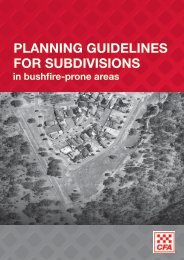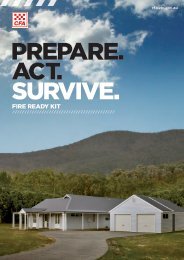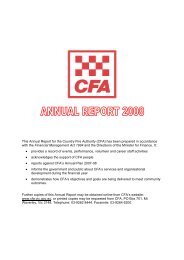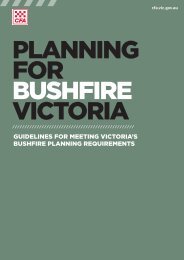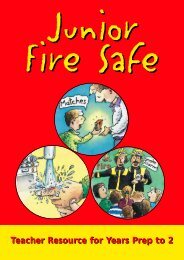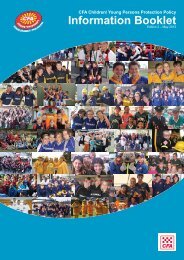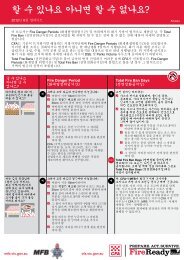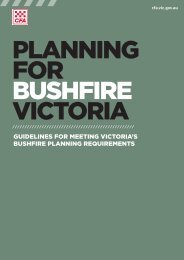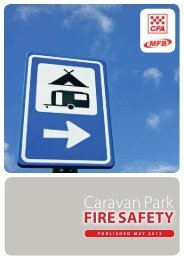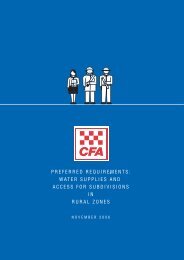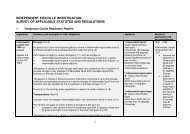Training Specifications and Guidelines - Country Fire Authority
Training Specifications and Guidelines - Country Fire Authority
Training Specifications and Guidelines - Country Fire Authority
Create successful ePaper yourself
Turn your PDF publications into a flip-book with our unique Google optimized e-Paper software.
Forest Industry Brigade<br />
<strong>Training</strong> Specification <strong>and</strong> <strong>Guidelines</strong><br />
Element<br />
PUAFIR303A<br />
Descriptor<br />
Performance criteria<br />
Suppress wildfire<br />
This unit covers competency while working as a member of a team when<br />
suppressing a wildfire <strong>and</strong> is often undertaken without direct supervision.<br />
Element<br />
1. Receive <strong>and</strong> report<br />
details of wildfire<br />
2. Prepare to respond to<br />
fire<br />
Performance criteria<br />
1. Details of the fire’s location <strong>and</strong> development of the fire are received <strong>and</strong><br />
recorded<br />
2. <strong>Fire</strong> details are reported in accordance with the organisation’s procedures<br />
1. The location of <strong>and</strong> access to the wildfire are confirmed <strong>and</strong> the most effective<br />
route is ascertained<br />
2. Required organisational equipment, protective clothing, apparel, food <strong>and</strong><br />
water required are assessed <strong>and</strong> procured before departure<br />
3. The most appropriate method of transport to the wildfire is selected <strong>and</strong> used<br />
3. Proceed to fire 1. The location of the wildfire is confirmed from observation or by direction while<br />
on approach<br />
2. Access to area is determined <strong>and</strong> achieved with minimum injury to personnel<br />
or damage to vehicles, equipment or environmentally sensitive areas<br />
3. The safety of people in the wildfire area is assessed <strong>and</strong> monitored<br />
4. Evidence of the wildfire cause is noted <strong>and</strong> brought to the attention of the<br />
appropriate authority<br />
5. Navigational tools are used for planning <strong>and</strong> operational purposes<br />
4. Protect people 1. As far as conditions allow, the number <strong>and</strong> location of people in the threatened<br />
area is determined<br />
2. Appropriate evacuation or non-evacuation protocols are identified <strong>and</strong> applied<br />
or advised to persons in the path of a wildfire<br />
3. Access to hazardous locations is controlled<br />
4. The safe defensibility of property is evaluated <strong>and</strong> assistance is provided to<br />
help occupiers<br />
5. Advice <strong>and</strong> support is provided to occupiers in helping them safely defend their<br />
property<br />
6. The safety of people in the threatened area is monitored during the course of<br />
the fire<br />
7. The safety of people in the area is checked <strong>and</strong> confirmed after the passing of<br />
the fire<br />
5. Combat wildfire 1. Media <strong>and</strong> equipment are selected <strong>and</strong> used to allow wildfire control<br />
operations to be conducted effectively <strong>and</strong> safely in accordance with the<br />
organisation’s procedures <strong>and</strong> OH&S procedures<br />
2. The most suitable location from which to use equipment to commence wildfire<br />
control operations is selected<br />
3. Access to the selected area of operations is gained in the safest <strong>and</strong> most<br />
effective manner<br />
4. <strong>Fire</strong> hazards are identified <strong>and</strong> action taken to minimise the risk of injury to the<br />
public, personnel <strong>and</strong> self<br />
5. <strong>Fire</strong> control strategies <strong>and</strong> tactics are employed to achieve the objectives in<br />
accordance with the organisation’s procedures<br />
6. <strong>Fire</strong> control activities undertaken minimise overall damage <strong>and</strong> impact on the<br />
environment<br />
7. Potential fire behaviour is considered <strong>and</strong> acted upon to ensure safety <strong>and</strong><br />
achievement of objective<br />
8. Fuel, weather <strong>and</strong> topographical factors are observed <strong>and</strong> potential fire<br />
behaviour anticipated<br />
9. The effectiveness of tactics employed is reported to the supervisor<br />
10. Area of origin <strong>and</strong> evidence of fire cause is protected <strong>and</strong> brought to attention<br />
of supervisor or relevant authority<br />
11. Safe egress <strong>and</strong>/or refuge from the fire is identified <strong>and</strong> communicated to<br />
personnel<br />
Edition 2,<br />
May 2008 Safety First Page 20



